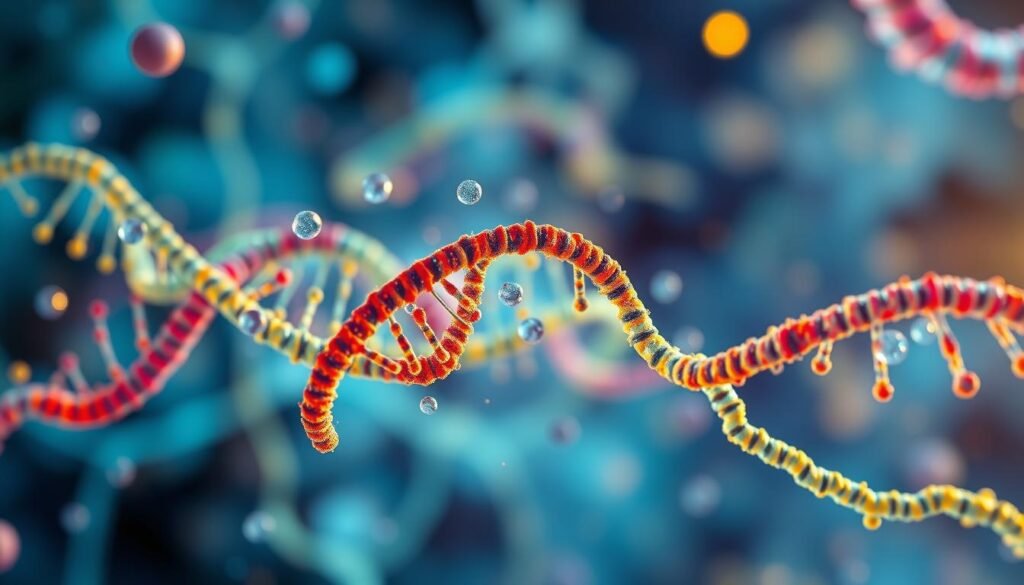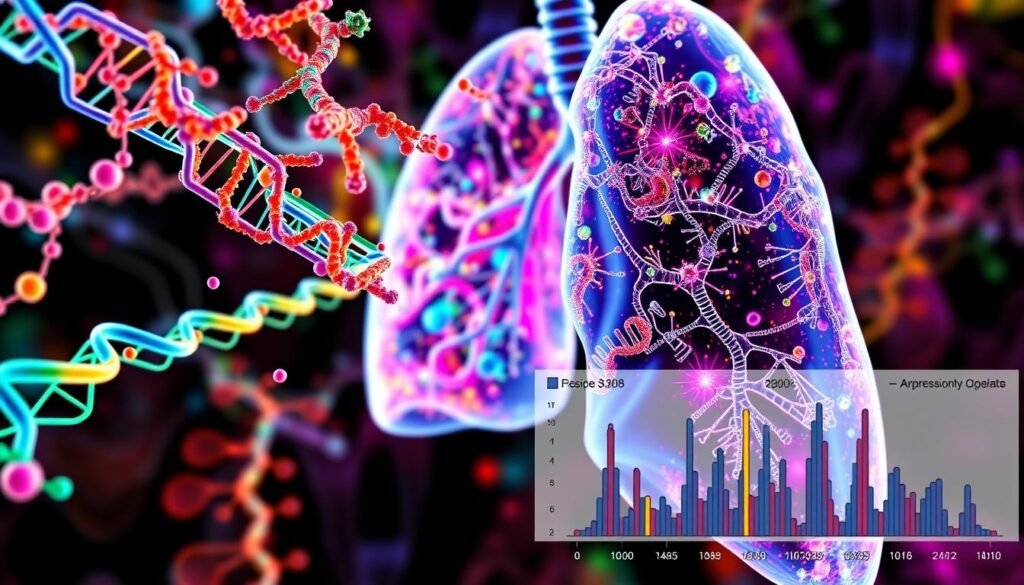Did you know nearly 25% of all cancer deaths in the U.S. are due to lung cancer? It’s a major challenge in the fight against cancer. Early detection is key to better survival chances. Excitingly, research into lung cancer blood test markers is changing the game. It could transform the way patients are detected and managed.
Latest breakthroughs highlight the value of non-invasive tests to find important biomarkers of lung cancer. These markers are tools for doctors to diagnose lung cancer, track its growth, and plan the best treatment for each patient. This guide will dive into the newest research on lung cancer blood markers. We’ll see how they’re improving screening and what the future of research looks like. For more insights on biomarker testing in lung cancer, keep reading.
Key Takeaways
- Lung cancer leads in cancer deaths, making early detection crucial.
- Blood test markers offer a non-invasive way to screen for lung cancer.
- Biomarkers are essential for diagnosing and customizing treatments for lung patients.
- Research is focused on making cancer screening more accurate and effective.
- New technologies are improving how biomarkers help doctors make decisions.
Introduction to Lung Cancer Detection
Finding lung cancer early is key to better outcomes for patients. Chest X-rays and LDCT scans are common but have downsides. They can be invasive and sometimes lead to wrong diagnoses. Also, patients often feel worried when waiting for their cancer test results.
Researchers are now looking at new ways to find lung cancer through blood tests. These blood tests are less invasive and deliver quick, accurate outcomes. This helps in catching the disease early. New methods are being developed to make these tests even more effective. This could lead to better treatment options.
A CBC blood test can tell doctors a lot about a patient’s health which is vital before treatment. Looking at CTCs and using liquid biopsies are also exciting new tools. They are promising in spotting and keeping an eye on lung cancer. As these technologies evolve, it’s important to understand all the ways to detect lung cancer today.
The Importance of Early Detection in Lung Cancer
Early detection is key in dealing with lung cancer effectively. Knowing the stats and how crucial timely finding is can make a big difference for patients. Lung cancer is the second most common cancer in the U.S. Despite this, the death rate from lung cancer is alarmingly high. Better screening methods can greatly improve how many people survive this disease.
Statistical Overview of Lung Cancer
Lung cancer is a top cause of cancer deaths worldwide. Latest figures show over 2.1 million new cases and 1.8 million deaths globally in 2018. Most lung cancer patients are diagnosed late, with cancer already spread to lymph nodes. This fact makes early detection crucial. Using low-dose CT scans can help find the cancer early and improve the chances of beating it.
Impact on Survival Rates
The five-year survival rate for lung cancer is about 18%. But finding it early can boost this rate significantly. When cancer is caught before spreading, patients have a much better chance of successful treatment. Screening with low-dose CT scans is advised for people 50 to 80 years old with a history of smoking. This can play a big role in lowering the number of deaths from lung cancer, showing how vital early detection is.
| Statistic | Data |
|---|---|
| New Lung Cancer Cases (2018) | 2.1 million |
| Lung Cancer Deaths (2018) | 1.8 million |
| Five-Year Survival Rate | Approximately 18% |
| Patients with Lymph Node Metastases | More than 66% |
Understanding Biomarkers in Cancer Diagnosis
Biomarkers are key in cancer diagnosis. They reveal insights into cancer types, progress, and treatment options. These molecules are found in our blood, body fluids, or tissues. They show if our body’s conditions are normal or not.
What Are Biomarkers?
Biomarkers are crucial in evaluating cancer. They help figure out someone’s cancer risk and identify the cancer type. Thanks to ongoing research, we know more about biomarkers like genetic changes and protein levels. This has improved mutation testing.
Types of Biomarkers Relevant to Lung Cancer
In lung cancer, important biomarkers are changes in genes like KRAS, EGFR, ALK, and others. These are mostly for non-small cell lung cancer. Comprehensive tests on these biomarkers help anticipate how a tumor will behave, its spread chances, and how to treat it.
Advanced methods like next generation sequencing test for DNA changes in tumor cells. This includes mutations and structural changes.
By understanding lung cancer biomarkers, we can offer customized treatment. As research on biomarkers gets better, it also improves how patients respond to targeted therapies.
Lung Cancer Blood Test Markers: Latest Research Findings
Recent studies on lung cancer have made big strides in finding blood test markers. These markers are key for better lung cancer detection. Researchers have looked into blood-based biomarkers like circulating tumor DNA (ctDNA) and circulating tumor cells (CTCs). They show hope for finding lung cancer early.
Latest research has improved detection methods by mixing traditional imaging with blood test markers. For example, a new blood test approach spotted more lung cancer cases than old methods. This could change who gets screened for lung cancer worldwide.
Studies on blood test markers reveal that certain panels show better diagnostic power. These panels include carcinoembryonic antigen (CEA), cytokeratin-19 fragment (CYFRA), and neuron-specific enolase (NSE). They offer a notable boost in detecting lung cancer accurately.

The progress in this research not only pushes lung cancer studies forward but also opens doors for new detection methods. As experts dive deeper into biomarkers, their focus stays on early detection and better treatments for lung cancer patients everywhere.
Innovative Techniques in Blood-Based Cancer Testing
New developments in cancer detection are making it easier to spot various cancers, like lung cancer, through blood tests. Liquid biopsy is one cutting-edge technique. It uses blood samples to check for cancer signs without invasive surgeries. By examining circulating tumor DNA and cells, doctors can track cancer’s progress in real time.
Liquid Biopsy Overview
Liquid biopsy is changing how doctors diagnose and watch over cancer. A study, the NCI-MATCH, found that nearly 79% of mutations in blood were also in tumor biopsies. This means blood tests are reliable for finding cancer. Also, 87% of patients treated were identified as microsatellite unstable, proving non-invasive tests work well.
Advantages of Non-Invasive Testing
Using liquid biopsies has many benefits. It’s less painful for patients and allows for easy, regular checks. Early and accurate cancer detection through these tests can lead to better treatment. Research in 2023 showed blood tests’ potential in picking patients for immunotherapy, making patient care better.
Blood tests continue to improve in spotting key genetic changes, like TP53 and PIK3CA mutations. Companies like Amadix are at the forefront with new blood tests for catching cancer early. For more about lung cancer detection, check out this informative resource.
| Mutation Detected | Frequency in Blood Samples | Response to Treatment (Microsatellite Unstable) |
|---|---|---|
| TP53 | Common | 87% |
| RNF43 | Moderate | — |
| PIK3CA | Occasional | — |
| MHL1 | Rare | — |
| MSH2 | Rare | — |
Circulating Tumor DNA and Its Role in Diagnosis
Circulating tumor DNA (ctDNA) is vital in lung cancer detection. It finds DNA fragments from tumor cells in the blood. This acts as an important marker.
The level of ctDNA offers insights into the tumor’s behavior. It helps doctors track how well treatment works and checks for therapy resistance.
How ctDNA Is Used in Lung Cancer Screening
ctDNA screening is a key step in finding lung cancer early. New methods offer precise ctDNA analysis. This boosts chances for early diagnosis.
Plasma samples are best for testing ctDNA. They let doctors accurately check for tumor DNA, even in small amounts. The success of ctDNA screening in early-stage lung cancer varies. This highlights the need for ongoing tech improvements.
Technological Advances in ctDNA Analysis
Technology has greatly advanced ctDNA analysis. Next-generation sequencing (NGS) spots mutations early on. This is more sensitive than older tests.
PCR techniques, like droplet digital PCR, find tiny ctDNA bits. Such progress helps doctors understand cancer better. This leads to improved care and planning for treatment.

| Technology Type | Limit of Detection | Advantages |
|---|---|---|
| Next-Generation Sequencing (NGS) | Below 0.01% | High sensitivity and ability to detect mutations across numerous genes |
| Droplet Digital PCR | 0.01% to 0.1% | Quantitative analysis of low-abundance mutations |
| BEAMing | 0.01% to 0.1% | Combines PCR amplification with magnetic beads for higher specificity |
| CAPP-Seq | Below 0.01% | Facilitates deep sequencing for detailed mutational landscape |
Circulating Tumor Cells: A New Perspective
Circulating tumor cells (CTCs) are a big deal in lung cancer monitoring. They show up in the bloodstream, revealing a lot about tumor movement and the risk of it spreading. As experts dig deeper into CTCs in cancer studies, it’s key to grasp how important these cells are.
Significance of CTCs in Lung Cancer
Finding circulating tumor cells is a game-changer for predicting outcomes in lung cancer patients. It helps doctors keep an eye on the disease and pick the right treatments. CTCs can show if treatments are working and if cancer might be coming back. This offers a gentler option over the usual biopsies. Thanks to new tech in tumor cell isolation, we’re getting better at counting and understanding CTCs. This makes them more useful in clinics.
Isolation Techniques for Circulating Tumor Cells
Getting CTCs out of blood is both exciting and tricky. Using a marker called EpCAM to find them works well for many cancers. But it might not catch all CTCs, especially in lung cancer where some don’t show EpCAM. The process called epithelial-to-mesenchymal transition (EMT) sheds light on why it’s critical to look for more markers. We need broader methods to find all kinds of CTCs. With new approaches, like special nanoparticles, we’re on the path to better detect and understand these cells.
Gene Expression Profiling and Lung Cancer
Gene expression profiling is key to unlocking lung cancer’s mysteries. It looks at gene activity in cancer tissues. This gives insight into how tumors behave and what they’re like. With this info, doctors can create better treatment plans for lung cancer patients.
Understanding Gene Profiling in Cancer
Researchers use gene profiling to tell different lung cancers apart. This includes non-small cell lung cancer (NSCLC) and small cell lung cancer (SCLC). They find specific genes that play a role in how the cancer grows. This information is crucial for prognosis and treatment response. A study found 84 genes that NSCLC and SCLC share. But it also uncovered genes unique to each type. The survival rates highlight the need for personalized treatment.
Clinical Applications of Gene Expression Profiling
Gene expression profiling makes lung cancer treatments better. It helps doctors decide on the best care for each patient. For example, genes like RRM2 and CHEK1 affect survival in NSCLC patients. Knowing this helps create more effective treatments. Moreover, gene expression can aid in early detection. This could lead to better lung cancer management and higher survival chances.

Integrating Precision Medicine in Lung Cancer Treatment
Precision medicine changes lung cancer care by focusing on each patient. It uses lung cancer biomarkers to create targeted treatments. These treatments are designed based on genetic differences. This method helps doctors come up with personal treatment plans that work better.
The Role of Targeted Therapies
Targeted therapies attack specific genes that cause lung cancer to grow. By spotting these genes, doctors can choose the best treatment. For instance, targeting the EGFR gene has helped some patients live longer. This shows why it’s important to use lung cancer biomarkers in planning treatment.
Biomarkers Influencing Treatment Decisions
Biomarkers are key in deciding the right treatment for lung cancer patients. They help doctors know who will benefit from certain therapies. The Precision Medicine Initiative is expanding the use of this data. It aims to improve disease classification and make treatment more personal.
Emerging Protein Markers in Lung Cancer Research
The search for protein markers is opening new paths in lung cancer research. Scientists are finding out how crucial these biomarkers are. They help diagnose, predict outcomes, and reveal how tumors react to treatments. This could lead to more personalized care for patients.
The Growing Interest in Protein Biomarkers
Lung cancer research has made big strides thanks to protein biomarkers. These markers offer a clearer picture of cancer than old methods did. They help identify unique proteins that tell benign growths from malignant ones. This helps doctors diagnose more accurately, bringing hope to many.
Specific Protein Markers Under Investigation
Researchers are now focusing on certain protein markers linked to lung cancer. These proteins give clues about how aggressive a cancer is. Finding them could change how doctors treat lung cancer and make predictions more precise. This research aims to make lung cancer diagnosis better and more reliable.
The Future of Lung Cancer Blood Testing
The future of lung cancer detection is changing fast. This is due to big steps forward in technology and a strong desire to make things better for patients. Now, the focus is on creating new blood tests. These tests could find lung cancer early on. This approach looks promising for not just spotting the disease sooner but also for starting the right treatment sooner.
Promising Research Directions
Researchers are looking into new biomarkers found in blood tests. Recent studies have shown that using advanced ways to sequence genes can teach us more about the proteins linked to lung cancer. Also, artificial intelligence is helping researchers to sift through big and complex sets of data more quickly. The push for innovations in lung cancer care comes from a desire to have screenings that better match each person’s risk, especially for those at high risk.
Challenges in Implementing New Technologies
Even with exciting progress, there are big hurdles to overcome. Getting new blood tests approved can take a lot of time and faces many hurdles. Then, there’s the issue of cost. Health systems must figure out if they can afford these new technologies. It’s also vital to get doctors and other healthcare workers to use these new tests. This is key to changing how we find and treat lung cancer.
Conclusion
The way we find lung cancer is changing fast. New studies on biomarkers lead to better tests. These tests play a big role in finding lung cancer early. This can really help improve survival rates. The accuracy of these tumor tests is key. They show big promise but using multiple markers together is the best way for accurate results.
New breakthroughs, like liquid biopsies and better scans, are making a big difference. They make it easier to tell if a condition is cancerous or not. This helps doctors find lung cancer early and choose the right treatment. Evidence shows that using markers like CEA and NSE together is more effective. It helps tell apart harmless conditions from lung cancer, proving how crucial diverse testing methods are.
In the end, winning against lung cancer depends on continuous research and working together. Investing in these blood tests and how to use them is essential. It helps doctors and patients make informed decisions early on. The future is bright. And the dedication to better lung cancer detection and treatment has never been more important.